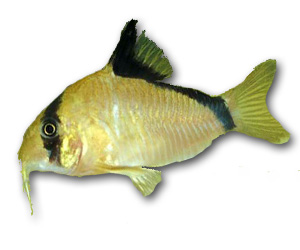Corydoras

Quick Stats
| Size | Up to 2" |
|---|---|
| Tank | 60 litres + |
| Swimming Area | Bottom |
| Ph | 6.5 to 8.0 |
| Temperature | 72ºF to 80ºF (22-29°C) |
| Food | Flakes and Catfish Pellets |
Common Name:
Corydoras.
Distribution:
Found throughout the Amazon river basin in Ecuador, Peru and Brazil.
Colouration:
The wild type is a muted coppery bronze. They are, and have the appearance of being heavily armored. There are many colour variations including albino and peppered.
Lifespan:
8 to 10 years.
Maintenance:
10% weekly water changes. Most species of Corydoras will tolerate a wide range of variations in temperature. A little prone to bacterial infections so good filtration and proper maintenance are needed.
Feeding:
Omnivorous and should be fed a varied diet. Do not simply rely on uneaten food on the bottom as there only source of food.
Substrate:
Sandy substrate is essential as Cory's will search the sand with their barbels for food.
Tank Decor:
The tank can be decorated with driftwood and a few live plants.
Filtration:
Good filtration required.
Biotype:
Amazon River watershed.
Breeding:
One of the harder species to breed, Sexually mature specimens are easy to tell apart, the females have a more stout body and are less colorful. The males have a larger and more pointed Dorsal fin. Easier to sex when viewed from above. You should have a ratio of two males to each female. Courtship consists of the male touching the female with his snout and then the female will swim constantly around cleaning rocks or plant leaves in the tank. Then a male will grab the females barbals and twist his body into hers and she will release her egg pouches at the same time as the male sperm. This is repeated several times with the female taking the egg pouches and placing them at various locations throughout the tank. After spawning you can remove the parents from the tank. The eggs will hatch in about five to eight days and the young are not hard to raise and can be fed fine flake food or newly hatched brine shrimp (fresh or frozen). Growth is fairly rapid given proper conditions.